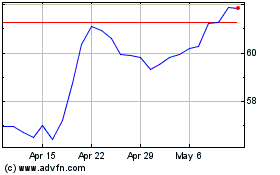How Wells Fargo's $1 Billion Settlement Affects Its Earnings -- Update
April 20 2018 - 7:27PM
Dow Jones News
By Michael Rapoport
Wells Fargo & Co. still has a hangover.
Long after other major banks moved beyond big regulatory
settlements, Wells Fargo is still coping with them. The latest, a
$1 billion pact unveiled Friday involving allegations of improper
charges to consumers in Wells' mortgage and auto-lending
businesses, cut into the bank's already-reported first-quarter
earnings and made it clear the San Francisco-based bank is in a
different place than most of its rivals.
Wells Fargo said its $1 billion settlement with the Consumer
Financial Protection Bureau and the Office of the Comptroller of
the Currency was prompting it to revise its first-quarter profit
downward by $800 million. That cuts the lender's earnings for the
period to 96 cents a share from the initially reported $1.12.
As a result, Wells Fargo's latest earnings declined from the
same year-earlier period instead of increasing as the bank had
first reported on April 13.
Wells Fargo indicated in that earnings release that regulators
had offered to resolve the matter for the $1 billion amount. The
bank on Friday didn't elaborate on why it cut earnings by $800
million when the settlement was for $1 billion, and a spoksman for
the bank declined to comment.
One possible explanation is that Wells Fargo previously set
aside reserves to cover $200 million of the amount. That could
suggest the $1 billion fine may have been higher than the bank had
been expecting before regulators made their offer.
Fitch Ratings said in a note earlier this week that while it had
incorporated an expected fine last fall on the auto portion of the
matter into its ratings approach, the $1 billion was higher than it
initially expected.
Barclays analyst Jason Goldberg noted, however, that a bank can
reserve for a legal settlement only if it is probable and
estimable. Wells Fargo "didn't have enough evidence" a week ago to
take the charge, he said.
Instead, Wells Fargo had cautioned in its initial announcement
of first-quarter results that it might later have to modify them if
a settlement was reached. The bank is following an accounting rule
governing so-called subsequent events. While the settlement was
reached after the end of Wells Fargo's first quarter, the events
that led to it occurred before the end of the quarter, and the
settlement effectively altered Wells Fargo's status at the end of
the first quarter.
That means the settlement has to be counted in first-quarter
earnings and reflected in the official quarterly numbers Wells
Fargo will file with the Securities and Exchange Commission.
The same rule has come into play before in banks' settlements
with regulators. In January 2013, several major banks reached
settlements over alleged mortgage abuses before they made any
earnings announcements for the fourth quarter of 2012, and the
impact of the settlements were counted against the banks' 2012
results.
Investors are taking the settlement in stride. Wells Fargo
shares rose 2% Friday, the best performance among large U.S
banks.
Write to Michael Rapoport at Michael.Rapoport@wsj.com
(END) Dow Jones Newswires
April 20, 2018 19:12 ET (23:12 GMT)
Copyright (c) 2018 Dow Jones & Company, Inc.
Wells Fargo (NYSE:WFC)
Historical Stock Chart
From Mar 2024 to Apr 2024

Wells Fargo (NYSE:WFC)
Historical Stock Chart
From Apr 2023 to Apr 2024
